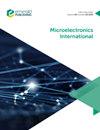A novel miniaturized Koch-Minkowski hybrid fractal antenna
IF 0.8
4区 工程技术
Q4 ENGINEERING, ELECTRICAL & ELECTRONIC
引用次数: 1
Abstract
Purpose Antenna miniaturization, multiband operation and wider operational bandwidth are vital to achieve optimal design for modern wireless communication devices. Using fractal geometries is recognized as one of the most promising solutions to attain these characteristics. The purpose of this paper is to present a unique structure of patch antenna using hybrid fractal technique to enhance the performance characteristics for various wireless applications and to achieve better miniaturization. Design/methodology/approach In this paper, the authors propose a novel hybrid fractal antenna by combining Koch and Minkowski (K-M) fractal geometries. A microstrip patch antenna (MPA) operating at 1.8 GHz is incorporated with a novel K-M hybrid fractal geometry. The proposed fractal antenna is designed and simulated in CST Microwave studio and compared with existing Koch fractal geometry. The prototype for the third iteration of the K-M fractal antenna is then fabricated on FR-4 substrate and tested through vector network analyzer for operating band/voltage standing wave ratio. Findings The third iteration of the proposed K-M fractal geometry results in achieving a 20% size reduction as compared to an ordinary MPA for the same resonant frequency with impedance bandwidth of 16.25 MHz and a directional gain of 6.48 dB, respectively. The operating frequency of MPA also lowers down to 1.44 GHz. Originality/value Further testing for the radiation patterns in an anechoic chamber shows good agreement to those of simulated results.一种新型微型化科赫-闵可夫斯基混合分形天线
目的天线小型化、多频带操作和更宽的操作带宽对于实现现代无线通信设备的优化设计至关重要。使用分形几何被认为是实现这些特性的最有前途的解决方案之一。本文的目的是利用混合分形技术提出一种独特的贴片天线结构,以增强各种无线应用的性能特性,并实现更好的小型化。设计/方法/途径本文将Koch和Minkowski(K-M)分形几何相结合,提出了一种新型的混合分形天线。一种工作于1.8的微带贴片天线(MPA) GHz与一种新的K-M混合分形几何相结合。在CST微波工作室对所提出的分形天线进行了设计和仿真,并与现有的Koch分形几何进行了比较。然后在FR-4衬底上制作了K-M分形天线第三次迭代的原型,并通过矢量网络分析仪对其工作频带/电压驻波比进行了测试。发现对于阻抗带宽为16.25的相同谐振频率,所提出的K-M分形几何的第三次迭代导致与普通MPA相比,尺寸减小了20% MHz和6.48的定向增益 dB。MPA的工作频率也降至1.44 GHz。原始性/值在消声室中对辐射模式的进一步测试显示出与模拟结果的良好一致性。
本文章由计算机程序翻译,如有差异,请以英文原文为准。
求助全文
约1分钟内获得全文
求助全文
来源期刊

Microelectronics International
工程技术-材料科学:综合
CiteScore
1.90
自引率
9.10%
发文量
28
审稿时长
>12 weeks
期刊介绍:
Microelectronics International provides an authoritative, international and independent forum for the critical evaluation and dissemination of research and development, applications, processes and current practices relating to advanced packaging, micro-circuit engineering, interconnection, semiconductor technology and systems engineering. It represents a current, comprehensive and practical information tool. The Editor, Dr John Atkinson, welcomes contributions to the journal including technical papers, research papers, case studies and review papers for publication. Please view the Author Guidelines for further details.
Microelectronics International comprises a multi-disciplinary study of the key technologies and related issues associated with the design, manufacture, assembly and various applications of miniaturized electronic devices and advanced packages. Among the broad range of topics covered are:
• Advanced packaging
• Ceramics
• Chip attachment
• Chip on board (COB)
• Chip scale packaging
• Flexible substrates
• MEMS
• Micro-circuit technology
• Microelectronic materials
• Multichip modules (MCMs)
• Organic/polymer electronics
• Printed electronics
• Semiconductor technology
• Solid state sensors
• Thermal management
• Thick/thin film technology
• Wafer scale processing.
 求助内容:
求助内容: 应助结果提醒方式:
应助结果提醒方式:


